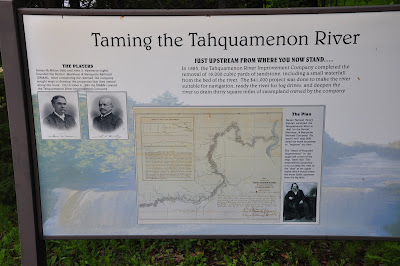Monday morning...our last day in the UP. There had been a freeze warning overnight, and it came true. During breakfast we heard folks talking about ice on the roads. When we loaded the car, we noted the glaze of ice on the windows. Yes...it was a chilly, but sunny, morning.
The advice we had gotten at dinner the night before was to head down this side road for some choice birds.
One that I heard was a swainson's thrush...another new one for me. Don and Robin drove up after we'd been there a while. Robin was shaking a baggie of some cheesy snack to try and call in the grey jays. These birds are notorious for following people or coming into camps to sneak food. Apparently they weren't too hungry this morning.
As we left the side road, we started to see the trilliums. Soon, whole swathes of roadside forest were carpeted with the flowers.
Not only were the numbers impressive, but so was their size. I know the white trilliums are called "large-flowered" trillium (
T. grandiflorum), but I've never seen them with flowers this large before. They were HUGE (and no, that's not just from the perspective of the camera to my hand)!
Soon we were back in our birding convoy, off to another dirt road leading into the woods, this time in search of the Connecticut warbler.
More potential mooseland...still no moose. What we did have was olive-sided flycatchers ("quick, three beers") and least flycatchers ("fitz-bew").
And we did hear the CT warbler. The diehard birders put on their wellies and headed into the woods to chase it down. Three of us stayed behind and went botanizing. Paul found a pink lady's slipper, and soon we found quite a few. All of them were bowed over...we suspect the overnight freeze was responsible.
The delicate white bud looks like an egg to me.
The birders returned victorious - they had seen the CT warbler within a few feet of where they stood.
On our way back to the main road, Paul, Libby and I stopped by a wetland to see the cotton grass up close, now dry and fluffy. They look like little truffula trees.
We also had red chokeberry in bloom.
We were now headed back home...it was time to play tourist again. Apparently people from "below the bridge" are called trolls.
Many of the sandy areas are eroded away by folks on ATVs.
We pulled off at a tourist trap called Castle Rock. There it is...and for a dollar you could climb up to the top and see the view.
I opted just to take a photo of Paul Bunyan and Babe instead.
Before long the bridge was in sight.
This time not only was the fog gone, but the lake (Michigan) was spectacularly colored.
Back on the LP (Lower Peninsula) we see a fort.
Is it reconstructed or the actual remains of Fort Michilimackinac? I don't know...we didn't stop. Plenty of school buses were there, though - last week of school field trips.
We stopped at a little park for lunch and a view of the bridge.
The park was home to this old buoy...
and to some pretty persistent gulls who wanted to share our lunch. They were disappointed.
I'd heard tales of Maciknack Island Fudge, so we stopped to get some. I gave it to my cat-sitter as part of my thanks for taking care of "the kids" for me.
The last stop on our trip was at the Big Buck Brewery (we passed it on the way up). Libby wanted to get a growler filled for her cat-sitter.
She had told me about the woodcarvings at the brewery, so I was armed with my camera to record them.
These are all carved on the bar:
beaver
ducks and lily pads
squirrel
otter
fish swimming behind the otter
We were back in Jackson by 5:00. It had been a long and very filled weekend. We'd all added new birds and plants to our various lists, and I had now seen more than just the southeastern part of Michigan. I have now whetted my appetite to see more of the state and to get back up to the UP.





























































